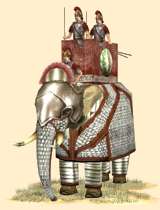Elephantes Kataphraktoi Indikoi (Armoured Indian Elephants)
 |
Weapons | Defence | Mental | ||||||
|---|---|---|---|---|---|---|---|---|---|
| Primary | Secondary | Armour: | 14 | Morale: | 7 | ||||
| Type: | spear | none | Shield: | 0 | Discipline: | normal | |||
| Attack: | 5 | 5 | Skill: | 6 | Training: | trained | |||
| Charge: | 0 | 63 | Recruitment | Other | |||||
| Lethality: | 1 | 0.2 | Soldiers: | 9 | Hit Points: | 1 | |||
| Range: | 57.8 | 0 | Cost: | 23000 | Mass: | 1 | |||
| Ammo: | 20 | 0 | Upkeep: | 5750 | |||||
| Turns: | 2 | ||||||||

Elephantes Kataphraktoi Indikoi are a powerful resource in combat, very popular among Alexandros' Diadochoi. These "towered" elephants are much less vulnerable then their unarmored corps, well protected by heavy armor on the front and sides.
Can Run Amok
Frightens Infantry
Imported from the regions around the old Eastern Persian provinces, Elephantes Kataphraktoi Indikoi are an exceptionally valuable resource in combat, very popular among Alexandros' Diadochoi. Towering over most other creatures, they can easily scare men and horses alike, with both their size and smell, though elaborate bells and trappings often add to their intimidation. Such corps are directed by their own mahouts riding behind their heads, often a native of their own country who has spent at least two years training his beast from capture. The mahout is armored to better protect against the obvious assault that generally comes against him, launched to bypass the thick natural armor of his mount. A thorakion (tower) or howdah is also attached to the elephant's back, which serves as a missile platform for a few archers. The elephant itself is also armored, protecting its head and sides and thus giving the elephants a much better chance at resisting enemy missile fire.
Elephants are best used as cavalry screens for your army, where their presence can scare away enemy cavalry. They can also be used to ram through an enemy battle line, though they are less useful when faced with loose order or phalanx infantry. Pyrrhos of Epeiros even innovated a tactic of flank screens when he fought the Romans at Herakleia. Beyond their obvious use against enemy infantry or cavalry, they can also be used in siege combat; battering down gates, though they're highly vulnerable to better prepared installations. Their greatest vulnerability is against skirmishers, slingers and archers, who can pepper them with missiles - eventually toppling them by virtue of their cumulative impact. To counter the effect of enemy skirmishers, it is often wise to array your own in opposition, or to maintain constant attacks upon each individual group. These "towered" elephants though are much less vulnerable then their unarmored corps, well protected as they are by their own armor and skirmisher mounts of their own.
Historically, the use of elephants in war was largely contained to India, but after the battle of Hydaspes that changed. Though Alexandros never cared over much for the animals, his successors were very much in favor of their use, organizing their own elephants into a distinct corps under their own "elephantarchos". These "Elephantes Kataphraktoi Indikoi" (Armoured Indian Elephants) were imported for war in the West from the old Eastern Persian provinces around Baktria, Gandhara, Sattagydia, and Sind - though most originally hailed from the regions directly around the river the natives call the Sindhu. In the first wars of succession, each Diadochoi had a contingent of Indian elephants and Indian mahouts, who stayed on where they taught the Hellenes how to capture and train elephants for war. Such forces had been wreaking havoc on battle lines for centuries within the armies of Indian Rajas, and the Diadochoi used them on an equal scale (the first substantial group supposedly numbered 500 elephants total, granted to Seleukos I Nikator by his new ally Chandragupta Maurya, called "Sandrokottos" in Greek), attaching substantial political power to their possession - some officers gained temporary power and success simply by this virtue (most notably, the Eastern Satrap Eumenes).
However, even with many different anti-elephant weapons being used and with the huge expenses, time and effort that had to be put into maintaining an elephant herd, the elephant was still employed so it shows that it was still valued and served its purpose. The Seleukeis even developed specific ‘elephant guards’ units, whose task was to solely defend these beasts. The elephant riders or the mahouts, were often called Indoi, as in the beginning they were all Indians and the majority of mahouts continued to be Indians, yet they did teach their skills to ‘westerners’ as well, as the Ptolemaioi did not have access to India yet they kept a sizeable elephant corps. The mahouts often wore protective armor as they were an obvious target for enemy missiles, even though ancient artists often portray them unarmored, which is highly likely to have been how they dressed for parades.
Other non-Hellenic powers also used Indian elephants in war, but it seems not to the same great extent. These powers started using elephants when they gained control of Indian provinces, such as the Pahlava, Kushan Empire and the Indo-Saka kingdoms.